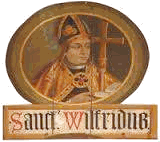The kingdom of Northumbria in the years 633/634 AD was a
centre of Irish Celtic learning and religion, centred around the abbey of
Lindisfarne. Sometime during these years a son was born to a nobleman, who
become one of the most powerful churchmen in Anglo-Saxon England and who,
amongst other deeds, was instrumental in changing the course of Christianity in
these islands.
Wilfrith, (later Wilfrid of York) as other saints of the
Celtic church before him, was educated at Lindisfarne becoming a monk. Being of
noble birth he had close ties with the court, which was to prove a mixed
blessing to him throughout his long life. Feeling that Lindisfarne had become
 somewhat
insular in its outlook, he left and went first to Canterbury and then on to
Rome. Here he studied scripture and canon law under the archdeacon Boniface. On
his way back to England he spent three years in Lyons and on his return he was
given the abbey of Ripon by Ahlfrith, the son of King Oswiu. Here he established
the Rule of St Benedict and followed customs favoured by the Roman church such
as the method of calculating Easter. It was his oratory at the Synod of Whitby
that pushed forward the cause of the Roman church over the older Celtic church
and the church established by Columba and his followers on Iona thus was doomed
to become history.
somewhat
insular in its outlook, he left and went first to Canterbury and then on to
Rome. Here he studied scripture and canon law under the archdeacon Boniface. On
his way back to England he spent three years in Lyons and on his return he was
given the abbey of Ripon by Ahlfrith, the son of King Oswiu. Here he established
the Rule of St Benedict and followed customs favoured by the Roman church such
as the method of calculating Easter. It was his oratory at the Synod of Whitby
that pushed forward the cause of the Roman church over the older Celtic church
and the church established by Columba and his followers on Iona thus was doomed
to become history.
Alhfrith elected him as bishop of York but because none of
the Celtic bishops were acceptable to Wilfrid (due to their allegiance to the
old church) he went to France to be consecrated at Compeigne. However, he stayed
away too long and on his return Alhfrith was no longer in power and his father
King Oswiu had appointed another scion of Lindisfarne, Chad, in his place.
Wilfrid retired to Ripon but not for long: three years later Theodore the
Archbishop of Canterbury deposed Chad and Wilfrid was reinstated. The following
years brought him power, influence and wealth. He enjoyed the favour of King
Egfrith and his Queen Ethelreda and obtained large endowments of land for his
churches. His church at Hexham was considered to be one of the finest north of
the Alps. He had a lavish lifestyle with a large household. His diocese extended
from the Wash to the Forth with York as its centre. This situation, however, was
not to last! Success breeds envy and resentment and Wilfrid’s ostentatious
lifestyle collected much criticism. Also, perhaps, his somewhat misguided
encouragement of the Queen to leave her husband and become a nun had made him
unpopular with that gentleman. During the years 678-81 Egfrith and Theodore went
over Wilfrid’s head and without his consent, they divided the Northumbrian
diocese into four. Wilfrid felt he had been unjustly deposed and made history by
being the first Anglo Saxon bishop to take his case to Rome. On his way to put
his case he spent a year preaching in Frisia, thus beginning the first such
mission on the Continent. The Pope ordered his restoration on condition that,
with a local council, he appoint two new bishops.
His return to Northumbria was not a successful one. King
Egfrith refused to accept the Pope’s decision and Wilfrid found himself
imprisoned for a spell, only being released when he agreed to leave the kingdom.
Wilfrid took himself off to the last stronghold of paganism in the land; Sussex,
where he preached and set up a monastery in Selsey until his reinstatement by
Theodore and his return in 686. He was never very far from controversy as a
series of disputes broke out with Alfrith, the new king of Northumbria over
endowments and the status of the monastery at Ripon. Wilfrid retired into the
kingdom of Mercia where he acted a s
bishop of Leicester and founded several more monasteries. However, trouble and
discord seemed to be following him. In 703 a synod in West Yorkshire decreed
that he resign his see of York, accept virtual disposition and confinement and
give up his monasteries. Again Wilfrid appealed to the papacy and again he was
vindicated, He returned in 705 having agreed to surrender his see of York to
John of Beverley. He retained full Episcopal control of Hexham and his
monasteries and he died in 709 at his monastery at Oundle in Northamptonshire.
His considerable fortune was left to four causes, offerings to Roman churches
(to the last he was an opponent of the old Celtic religion), to the poor, to his
followers who had shared his exile and to his abbots ‘so that they could
purchase the friendship of kings and bishops’. It was his belief that this was
the best way to secure the continuity of the monasteries.
s
bishop of Leicester and founded several more monasteries. However, trouble and
discord seemed to be following him. In 703 a synod in West Yorkshire decreed
that he resign his see of York, accept virtual disposition and confinement and
give up his monasteries. Again Wilfrid appealed to the papacy and again he was
vindicated, He returned in 705 having agreed to surrender his see of York to
John of Beverley. He retained full Episcopal control of Hexham and his
monasteries and he died in 709 at his monastery at Oundle in Northamptonshire.
His considerable fortune was left to four causes, offerings to Roman churches
(to the last he was an opponent of the old Celtic religion), to the poor, to his
followers who had shared his exile and to his abbots ‘so that they could
purchase the friendship of kings and bishops’. It was his belief that this was
the best way to secure the continuity of the monasteries.
His cult was centred on Ripon (where he is buried) and
Hexham. Dispute and division pursued him into the tenth century when there was a
division of his cult with the translation of his relics being claimed by both
Canterbury and Worcester. His feast day is 12th October. Without
doubt he was a great orator and evangelist both in England and overseas. St
Willibrord the patron saint of Holland was his pupil. He was a great builder of
churches and monasteries, bringing the Benedictine Rule to England. He was a
patron of the arts. His fortitude and persistence in the face of his opponents
was amazing and his devotion to the Roman church and his belief in the supremacy
of the papacy over local and secular interests was absolute. This position, at a
time when the rulers of the various Anglo-Saxon kingdoms expected their bishops
and priests to put secular interests first, was extremely courageous. Some
extremely important and influential churchmen have come out of the north of
these islands and St Wilfrid was certainly one of them.
Barbara Hothersall
 somewhat
insular in its outlook, he left and went first to Canterbury and then on to
Rome. Here he studied scripture and canon law under the archdeacon Boniface. On
his way back to England he spent three years in Lyons and on his return he was
given the abbey of Ripon by Ahlfrith, the son of King Oswiu. Here he established
the Rule of St Benedict and followed customs favoured by the Roman church such
as the method of calculating Easter. It was his oratory at the Synod of Whitby
that pushed forward the cause of the Roman church over the older Celtic church
and the church established by Columba and his followers on Iona thus was doomed
to become history.
somewhat
insular in its outlook, he left and went first to Canterbury and then on to
Rome. Here he studied scripture and canon law under the archdeacon Boniface. On
his way back to England he spent three years in Lyons and on his return he was
given the abbey of Ripon by Ahlfrith, the son of King Oswiu. Here he established
the Rule of St Benedict and followed customs favoured by the Roman church such
as the method of calculating Easter. It was his oratory at the Synod of Whitby
that pushed forward the cause of the Roman church over the older Celtic church
and the church established by Columba and his followers on Iona thus was doomed
to become history. s
bishop of Leicester and founded several more monasteries. However, trouble and
discord seemed to be following him. In 703 a synod in West Yorkshire decreed
that he resign his see of York, accept virtual disposition and confinement and
give up his monasteries. Again Wilfrid appealed to the papacy and again he was
vindicated, He returned in 705 having agreed to surrender his see of York to
John of Beverley. He retained full Episcopal control of Hexham and his
monasteries and he died in 709 at his monastery at Oundle in Northamptonshire.
His considerable fortune was left to four causes, offerings to Roman churches
(to the last he was an opponent of the old Celtic religion), to the poor, to his
followers who had shared his exile and to his abbots ‘so that they could
purchase the friendship of kings and bishops’. It was his belief that this was
the best way to secure the continuity of the monasteries.
s
bishop of Leicester and founded several more monasteries. However, trouble and
discord seemed to be following him. In 703 a synod in West Yorkshire decreed
that he resign his see of York, accept virtual disposition and confinement and
give up his monasteries. Again Wilfrid appealed to the papacy and again he was
vindicated, He returned in 705 having agreed to surrender his see of York to
John of Beverley. He retained full Episcopal control of Hexham and his
monasteries and he died in 709 at his monastery at Oundle in Northamptonshire.
His considerable fortune was left to four causes, offerings to Roman churches
(to the last he was an opponent of the old Celtic religion), to the poor, to his
followers who had shared his exile and to his abbots ‘so that they could
purchase the friendship of kings and bishops’. It was his belief that this was
the best way to secure the continuity of the monasteries.